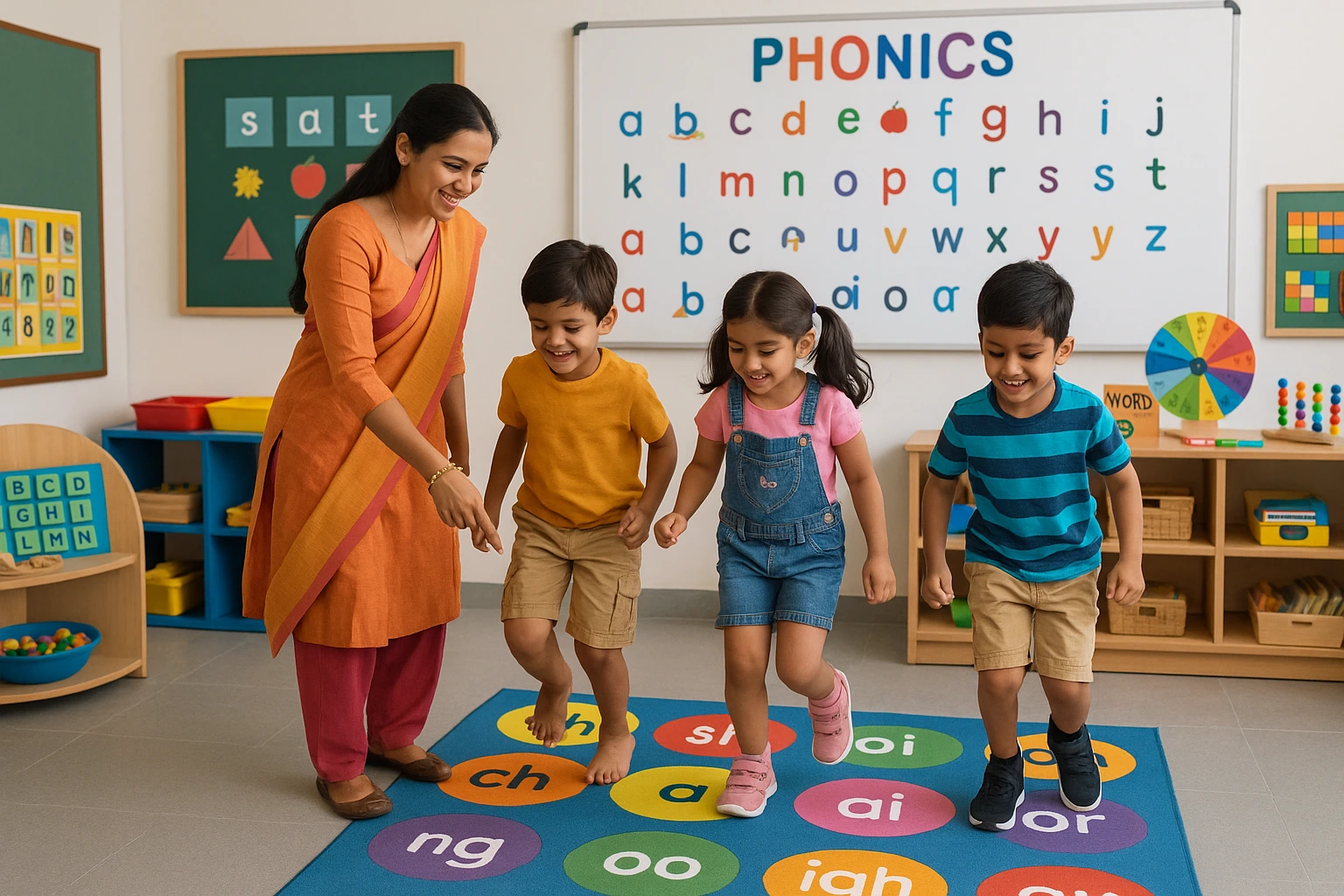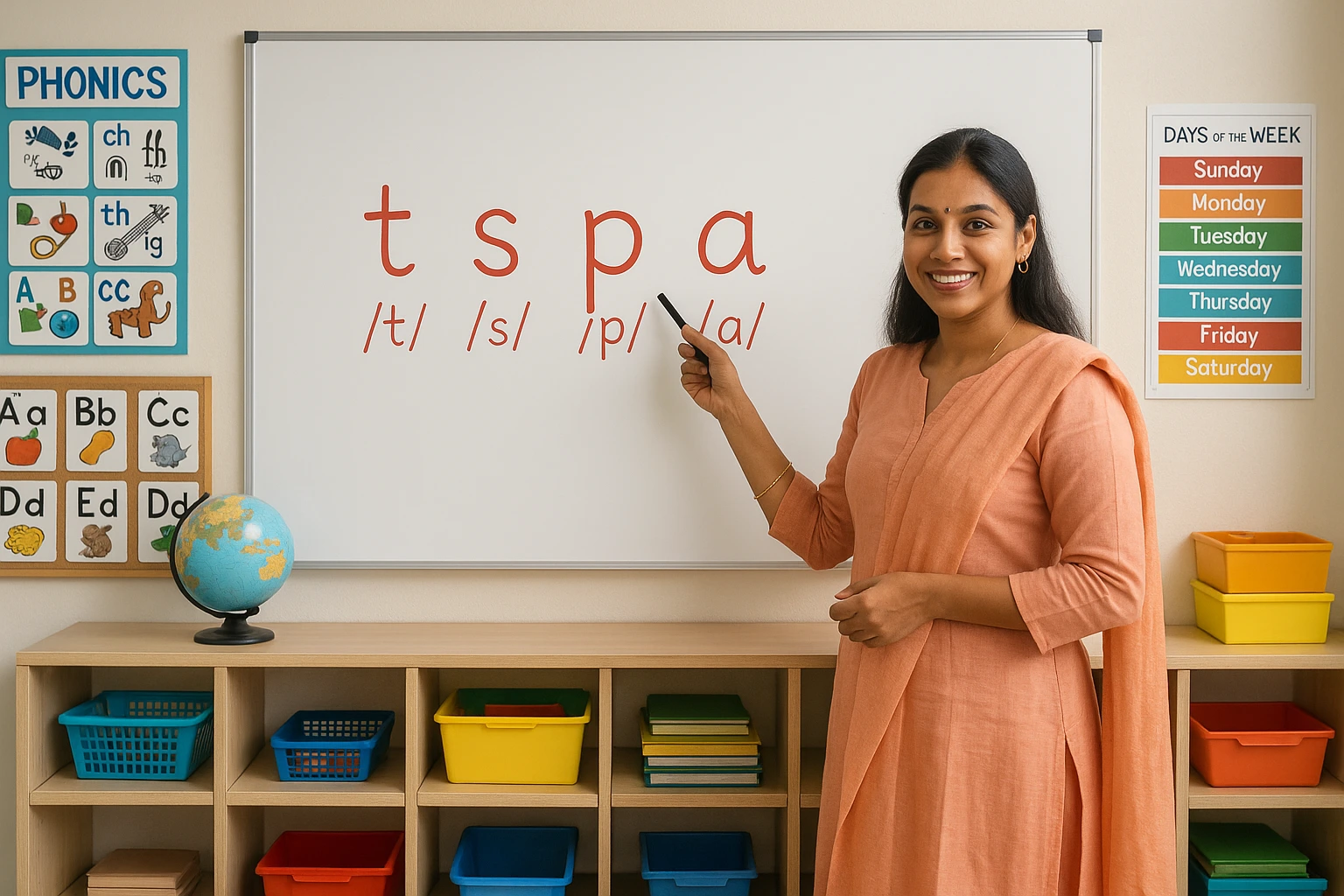How to Teach Phonics Sound for Beginners?
How to Teach Phonics Sound for Beginners?
Phonics, an instructional method, teaches children how letters and letter-groups sound, enabling them to connect uttered language to written words. Teaching Phonics Sound for Beginners can initially appear challenging, but it becomes fun and effective with exemplary methods. Beginning with letter sounds rather than names builds a robust foundation. Through this blog, you’ll discover functional ways to teach Phonics Sound for Beginners using fun, simple approaches that support early literacy growth.
Table of Content
How to Teach Phonics Sounds?
Teaching Phonics Sound for Beginners requires a stepwise approach that builds language familiarity and confidence in young learners. It concentrates on letters and sounds, laying the basis for reading and spelling.
For downloading the brochure about Phonics Course, Click Here!
Call or Whatsapp on +918104606573 / +919869866277, for Admission Details of Phonics
Here are some practical ways to Teach Phonics Sounds:
- Start with letter sounds: Before teaching letter names, introduce the most familiar Phonics Sound for Beginners. Begin with sounds like /t/, /s/, /p/, /a/, which can be blended smoothly.
- Use graphical aids: Flashcards, letter graphs, and graphic books help children correlate letters with familiar images and sounds.
- Integrate songs and actions: Integrating catchy phonics songs or simple hand gestures makes it more manageable for children to recollect each sound.
- Focus on blending: Once a few sounds are learnt by children, train them how to blend them to form easy words (e.g., s-a-p = sap).
- Practice every day: Maintain uniformity and keep lessons brief. Every day repetition helps sounds stick.
- Correct gently: On mispronunciation of a sound by a child, model the right sound politely, without being offensive.
An interactive and dynamic learning approach ensures that children appreciate the learning process while mastering vital reading and spelling skills.

How to Teach Phonics Step By Step for Beginners?
Teaching Phonics Sound for Beginners builds adept reading skills from the ground up. An organized approach ensures children learn sounds in a manner that is easy to comprehend and remember.
One can adopt the following methods to Teach Phonics Step By Step for Beginners:
- Step 1: Start with letter sounds: Initiate with short vowels and common consonants. Teach sounds like /m/, /a/, /s/, /t/, /i/, /p/, etc.
- Step 2: Familiarize with letter-sound correspondence: Use illustrations to help children relate letters and sounds.
- Step 3: Teach blending sounds to form words: Connect familiar sounds to create simple words comprising consonant-vowel-consonant (CVC words.) For example- cat, mat, pin, tap, etc.
- Step 4: Focus on segmenting words: Guide children in splitting words into respective sounds (e.g., pit- /p/ /i/ /t/).
- Step 5: Introduce digraphs and vowel teams: Slowly familiarize early learners with digraphs and vowel teams like ch, sh, ee, oa, etc.
- Step 6: Regular reading practice: Regular practice using phonics readers and word-building activities supports learning.
Following these steps to Teach Phonics Sound for Beginners creates adept phonics skills in early readers.

Source: landmarkschool
How to Teach Phonics at Home?
With the right approaches and routine, Teaching Phonics at Home can become a delightful experience for parents and children as well. It helps children develop reading skills through active learning experiences in a warm setting.
Here’s How to Teach Phonics at Home Effectively:
- Daily practice: Devoting 10–15 minutes every day for phonics practice gives wonderful results.
- Use phonics flashcards: Present one or two letter sounds at a time using flashcards with pictures for better memory.
- Combine household articles: Use articles around the home as examples to help associate sounds with spoken words (e.g., f for fan, c for cup).
- Play sound-based games: Games like “I Spy” with initial sounds or sound-matching quizzes keep learning fun.
- Practice blending and segmenting: Practice blending and segmenting sounds for enhanced acquaintance.
- Read aloud using phonics readers: Select beginner readers with easy, phonics-based words to support learning.
- Repeat and review often: Revisiting sounds regularly helps children retain and use them while reading.
A calm and encouraging environment at home supports learning Phonics Sound for Beginners and can build adept reading skills over time.
What Sounds to Teach First?
Determining the Sounds to Teach First is essential when introducing Phonics Sound for Beginners. Starting with easy and typically used sounds helps children build confidence and early reading success. The best way to introduce Phonics Sound for Beginners is in a sequence that allows quick word formation.
Teach Phonics Sound for Beginners by beginning with the following:
- P, I, A, S, N, T: These sounds form several simple words like sat, pin, tap, nap, tin, sip, etc.
- M, D, G, O, C, K: On mastering the first set, move to this group to extend word-building prospects.
- E, U, B, F, H, L, R: These add variety and support reading more CVC words.
Tips for introducing Phonics Sound for Beginners:
- As lowercase letters are more generally seen in texts, introduce them first.
- To build blending skills early, concentrate on letter sounds, not names.
- Support with graphics, motions, and repetition to help children retain sufficiently.
- Integrate easy words and real-life illustrations to associate learning with their day-to-day affairs.
Introducing the right Phonics Sound for Beginners allows children to begin reading early, which builds an interest in phonics learning.

Make Learning Phonics Fun
Making Phonics Fun and dynamic keeps early learners fascinated and helps them absorb sounds more smoothly. They are more likely to participate and retain what they’ve learned when learning feels like play. Making Phonics Fun also aids those who hope to teach it effectively. Vidhyanidhi Education Society presents a Phonics Teacher Training Course that provides aspiring educators with applicable tools and visionary strategies.
Here are a few ideas to Make Learning Phonics Fun:
- Use songs and rhymes to teach sounds rhythmically. This enhances memory and adds delight to the learning process.
- Play phonics games like sound bingo, letter quests, or matching games to make routine enjoyable.
- Create crafts or drawing activities that connect sounds to pictures and actions.
- Use storytelling and phonics books with simple, repetitive sounds to reinforce letter-sound connections.
This Phonics Teacher Training Course covers everything from sound introduction to blending and word building. It also includes methods to make learning enjoyable for different age groups.
Whether you’re a parent or teacher, the right approach matters. With the Phonics Teacher Training Course by Vidhyanidhi Education Society (Govt. Regd.), teaching Phonics Sound for Beginners becomes both effective and engaging.
Join Vidhyanidhi’s Phonics Course and start shaping confident young readers today!
For downloading the brochure about Phonics Course, Click Here!
Call or Whatsapp on +918104606573 / +919869866277, for Admission Details of Phonics
FAQs
Which Letter is Never Silent?
The letter V is almost never silent in English words. It consistently carries its sound in both common and complex vocabulary.
How to Start Phonics Classes at Home?
Begin with letter sounds, simple blending, and fun games. Vidhyanidhi Education Society also offers a Phonics Teacher Training Course for guidance.





